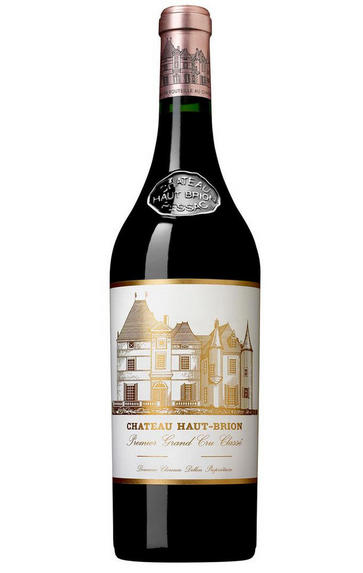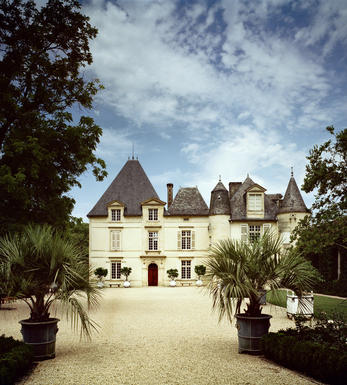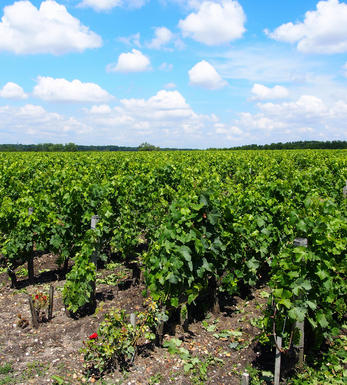
2018 Château Haut-Brion, Pessac-Léognan, Bordeaux

Critics reviews
The 2018 Haut-Brion was double decanted, assessed after two hours and then over 24 hours, initially blind against La Mission Haut-Brion. There is more red fruit on the nose compared to the La Mission Haut-Brion, wild strawberries commingling with raspberry, light tobacco scents and shavings of black truffle. The palate is medium-bodied and beautifully balanced with superb salinity.
Maybe this is more elegant and seductive than the La Mission thanks to the killer line of acidity, though it has slightly less backbone and grip by comparison. Oddly, this First Growth is the most approachable of the pair. It has wonderful cohesion and harmony toward the precise, captivating finish. Superb. My hunch is that this will have wider appeal in its youth, and then the La Mission might put its nose in front after 15–20 years.
Drink 2024 - 2060
Neal Martin, Vinous.com (March 2021)
The 2018 Haut-Brion is an infant, but its balance and potential are both amply evident. Rich and deep in the glass, the 2018 opens to reveal tremendous complexity and nuance, qualities that only grow with time. The 2018 is not a huge Haut-Brion, nor is it massively endowed, but it is so elegant and classy. I loved it.
Drink 2024 - 2058
Antonio Galloni, Vinous.com (March 2021)
Harvested from 6 September to 2 October, yields 44hl/ha. 3.8pH.
Fourth generation of the Dillon family at Haut-Brion today, overseeing the extremely challenging act of keeping a First Growth at the top of its game. This is laying down the gauntlet - powerfully built, complex and succulent layers of tight black fruits and grilled oak, overlaid with charcoal, cloves, tobacco, slate, sage and smoked earth, nuanced and unwilling to show its hand too soon. Needs a good five to eight years more, and will age for decades.
Drink 2028 - 2048
Jane Anson, JaneAnson.com (September 2021)
Tasted blind. Paler than most of its peers. Sweet, neat start with some fresh minerality. And some pretty dry tannins on the end.
Drink 2028 - 2048
Jancis Robinson MW, JancisRobinson.com (February 2022)
The 2018 Haut-Brion is composed of 49.4% Merlot, 38.7% Cabernet Sauvignon and 11.9% Cabernet Franc.
Deep garnet-purple in colour, the wine needs a lot of swirling before it begins to release a whole complex melody of notes, one at a time to begin: tilled earth, followed by pronounced liquorice, then crushed rocks, then the preserved plums. Eventually, it all comes together into a fascinating crescendo of intense crème de cassis, rose oil, wild blueberries and kirsch notes, giving way to quiet, persistent leitmotif scents of cinnamon stick, truffles and redcurrant jelly.
The medium to full-bodied palate delivers all this and more, revealing tightly wound black fruit, red berry and exotic spice layers within a solid, wonderfully plush frame and seamless freshness, finishing with epic length and loads of earth and mineral sparks. This is a profound, highly intellectual, multilayered baby, which will require a good 7-8 years to begin to sing its incredible song, then should cellar a further 40 years at least. By way of reference, think of 1989 with more restraint and even greater purity.
Drink 2028 - 2068
Lisa Perrotti-Brown, Wine Advocate (March 2021)
Aromas of currants, leaves, fresh mushrooms, oyster shell, tobacco, and dried flowers, following through to a full body, yet ever so refined and polished and it grows on the palate. Lovely, energetic finish. Subtle and driven at the end of the palate.
Drink in 2026 and onwards
James Suckling, JamesSuckling.com (February 2022)
Another stellar vintage for this always elegant first growth. Despite a stormy spring and May hailstorm, September harvest conditions were ideal. What stands out for me is the elegance, intense purity and a juicy, vibrant freshness that seems to be the hallmark of the vintage. It's generous, velvety and wonderfully complex, with aromas of tobacco, black truffle, and rich red and black fruit flavours.
Drink 2027 - 2050
Elin McCoy, Decanter.com (June 2023)
A quintessential expression of this terroir, the 2018 Château Haut-Brion checks in as 49.4% Merlot, 38.7% Cabernet Sauvignon and the balance Cabernet Franc brought up in a mix of new and used barrels. Ripe and sexy, yet also offering subtle aromas and flavors of blackcurrants, smoked earth, tobacco leaf, truffle, lead pencil, and minerals, it takes its time opening up but reveals a full-bodied, concentrated, multi-layered style carrying gorgeous tannins, flawless balance, and just a wonderful symmetry and elegance paired with beautiful richness. This noble, gorgeous Haut-Brion will benefit from 7-8 years of bottle age and cruise for 40 years or so.
Drink 2028 - 2068
Jeb Dunnuck, JebDunnuck.com (March 2021)
About this WINE

Chateau Haut-Brion
The only property from outside the Médoc to be included in the 1855 Classification, Haut-Brion’s viticultural history can be traced back further than its Médoc First Growth counterparts. Samuel Pepys even mentions it in his diaries. Situated in what is now Pessac-Léognan, the property finds itself now in the suburbs of the ever-encroaching city of Bordeaux.
After falling into a state of disrepair the estate was purchased in 1935 by Clarence Dillon, an American financier, since when it has enjoyed a steady and continual resurgence to a position of pre-eminence. Dillon’s great-grandson, Prince Robert of Luxembourg, now runs the estate, but a key influence in the reputation which Haut-Brion enjoys today is the Delmas family. George Delmas was manager and wine-maker until 1960, when his son Jean-Bernard took over. Jean- Bernard was a visionary figure, responsible for a number of important innovations, and on his retirement in 2003 his son Jean-Philippe took over as Directeur Générale.
The vineyard is planted to 40% Cabernet Sauvignon, 37% Merlot and 18% Cabernet Franc. A stunning white wine is also made, from a part of the vineyard which is 63% Semillon and 37% Sauvignon Blanc. Production is smaller than at the other First Growth Wines, totalling about 20,000 cases, shared between the Grand Vin and a second wine, formerly called Bahans-Haut-Brion but changed in 2007 to Clarence de Haut-Brion in recognition of Clarence Dillon. Production of Haut Brion Blanc is minute, less than 800 cases in most years.
Beginning with the 2009 vintage a new white wine was introduced in the place of Clarence: La Clarté de Haut-Brion, the offspring of Domaine Clarence Dillon's two prestigious white wines: Château Haut-Brion Blanc and Château La Mission Haut-Brion Blanc.
Fermentation of the red wines takes place in stainless steel vats, after which the wine will spend 22 months, sometimes more, in new oak barrels before being bottled unfiltered. For the white wine fermentation takes place in new oak barrels, after which the wine spends a further year to 15 months on its lees in barrel before bottling. The white wine is truly sensational, equivalent in class to a top-flight White Burgundy Grand Cru, but its scarcity means that it is rarely seen.
The red wine is no less extraordinary; at its best it displays text-book Graves characteristics of cigar-box, curranty fruit, earth, smoky spice and cassis. The high Merlot content, compared to the Médoc First Growths, gives it a voluptuous edge, but does not in any way detract from its ability to age.

Pessac-Leognan
In 1986 a new communal district was created within Graves, in Bordeaux, based on the districts of Pessac and Léognan, the first of which lies within the suburbs of the city. Essentially this came about through pressure from Pessac-Léognan vignerons, who wished to disassociate themselves from growers with predominately sandy soils further south in Graves.
Pessac-Léognan has the best soils of the region, very similar to those of the Médoc, although the depth of gravel is more variable, and contains all the classed growths of the region. Some of its great names, including Ch. Haut-Brion, even sit serenely and resolutely in Bordeaux's southern urban sprawl.
The climate is milder than to the north of the city and the harvest can occur up to two weeks earlier. This gives the best wines a heady, rich and almost savoury character, laced with notes of tobacco, spice and leather. Further south, the soil is sandier with more clay, and the wines are lighter, fruity and suitable for earlier drinking.
Recommended Châteaux: Ch. Haut-Brion, Ch. la Mission Haut-Brion, Ch. Pape Clément, Ch Haut-Bailly, Domaine de Chevalier, Ch. Larrivet-Haut-Brion, Ch. Carmes Haut-Brion, Ch. La Garde, Villa Bel-Air.

Cabernet Sauvignon Blend
Cabernet Sauvignon lends itself particularly well in blends with Merlot. This is actually the archetypal Bordeaux blend, though in different proportions in the sub-regions and sometimes topped up with Cabernet Franc, Malbec, and Petit Verdot.
In the Médoc and Graves the percentage of Cabernet Sauvignon in the blend can range from 95% (Mouton-Rothschild) to as low as 40%. It is particularly suited to the dry, warm, free- draining, gravel-rich soils and is responsible for the redolent cassis characteristics as well as the depth of colour, tannic structure and pronounced acidity of Médoc wines. However 100% Cabernet Sauvignon wines can be slightly hollow-tasting in the middle palate and Merlot with its generous, fleshy fruit flavours acts as a perfect foil by filling in this cavity.
In St-Emilion and Pomerol, the blends are Merlot dominated as Cabernet Sauvignon can struggle to ripen there - when it is included, it adds structure and body to the wine. Sassicaia is the most famous Bordeaux blend in Italy and has spawned many imitations, whereby the blend is now firmly established in the New World and particularly in California and Australia.


Buying options
Add to wishlist
Description
49% Merlot, 39% Cabernet Sauvignon, 12% Cabernet Franc.
A dense wine, and with a hint of opulence. Jean-Philippe Delmas is not yet sure where the 2018 will sit against 2010, ‘15 and ‘16, but Haut-Brion’s experience dealing with warm vintages means the wine is assured a place at the top table. For all the wine’s intensity, there is also discretion within its velvety, smoky earthiness.
Drink 2030 - 2060
Berry Bros. & Rudd
wine at a glance
Delivery and quality guarantee